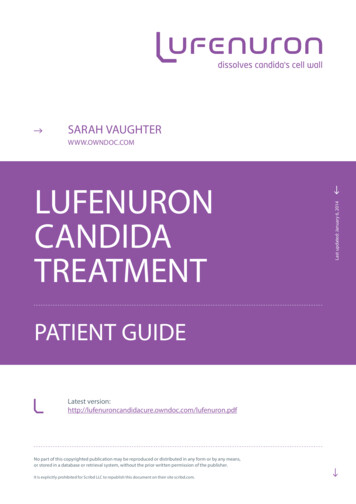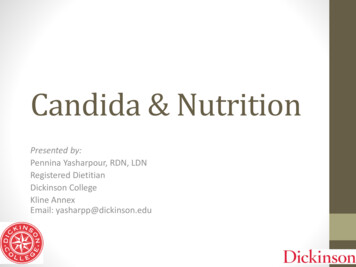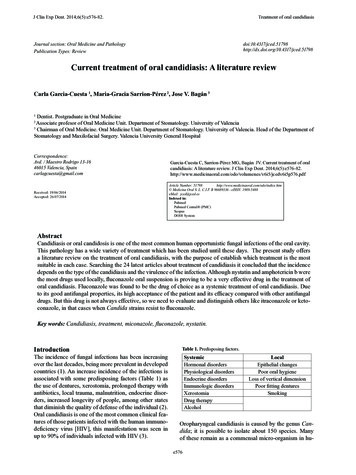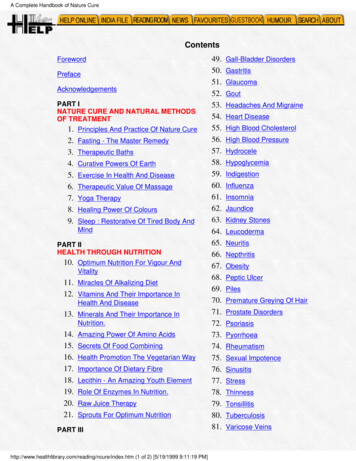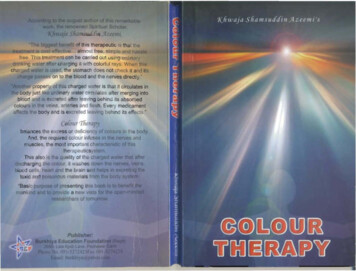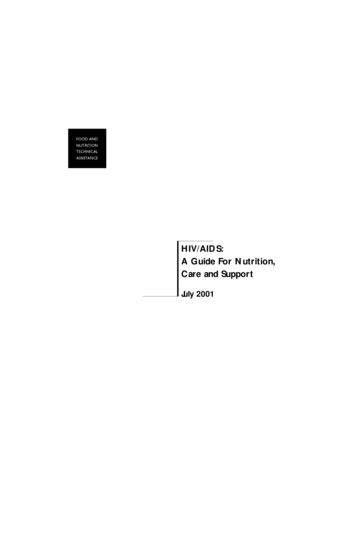
Transcription
HowToCureCandida.com – The Full GuideHow to Cure CandidaThe Full Guide to CompletelyRegaining Your HealthBrought to you by:www.TotalWellnessConsulting.ca1 PageCopyright 2008 by HowToCureCandida.com
HowToCureCandida.com – The Full GuideTABLE OF CONTENTSAN INTRODUCTION TO CANDIDA1. What is Candida?2. What are common causes of Candida?3. What are signs, symptoms and types of Candida?a. Common symptoms of Candidab. Common symptoms of Candida localizedc. Other localized Candida infections4. How is Candida different in males and females?5. How does Candida develop into a health threat?6. How do I determine if I have Candida?TREATMENTS1. How is Candidiasis treated?a. Drugs used in the topical treatment of Candidab. Drugs used in the treatment of systemic Candidac. The problem with treating Candida through drugs2. How is Candidiasis treated naturally?a. Restoring a healthy balance of microorganismsb. Restoring and maintaining the health of your immune system.c. Eliminating behaviors that increase your risk of developing an infection3. What can I do to feel better now?4. Treatment plans for specific Candida infections5. Being responsible for your own healthTHE 5 STEP PROTOCOL FOR TOTAL CANDIDA RECOVERY1. The Anti-Candida Dieta. What foods should I avoid if I have Candida?b. What foods can I eat if I have Candida?c. How long should I stay on the anti-Candida diet?d. Quick reference tablee. Additional tipsThe Healthy Lifestyle2. Supplements and Alternative Therapies3. Parasite And Kidney Cleanse4. Heavy Metal Removals and Detoxification5. The Liver FlushA CANDIDA FREE FUTURE2 PageCopyright 2008 by HowToCureCandida.com
HowToCureCandida.com – The Full GuideThis Book Is Dedicated To YouThis book is dedicated to those of you who feel that your current state ofhealth is not what it should be. This book is dedicated to those of youwho have sought assistance with no real improvements. This book isdedicated to those of you who have spent endless amounts of time, effortand money into finding a real solution with no avail.It is our intention that this book will bring you clarity to all your healthproblems.Take the information from this book and apply it as you see fit andreclaim your life. Some ideas and concepts may seem overwhelming at first or appearunnecessary. This is fine as it not our intention to manipulate you into changing your lifestyle.Our goal rather is to empower you to make the necessary changes in your life to control it.Our team feels blessed that we have gone through all the horrors of Candida.Why? As a result of our health challenges we have been able to share allour trials and tribulations and come up with solutions for an unlimitednumber of people worldwide. The saying every cloud has a silver lining hasnever rang more true!It’s time to rejoice and embrace the fact that there is a permanent naturalcure for Candida! You can feel energized and healthy again. You now havethe solution at your fingertips.HowToCureCandida.comThe information contained in this publication has not been evaluated by the Food and DrugAdministration nor is it intended to replace the services and recommendations of a physician orqualified health practitioner. All statements are for informational purposes only. Individuals withhealth problems or those who are pregnant are specifically advised that they should consult theirphysician before taking any natural remedies, over the counter treatments, dietary supplements, orinstituting any diet changes.3 PageCopyright 2008 by HowToCureCandida.com
HowToCureCandida.com – The Full GuideAN INTRODUCTION TO CANDIDAWhat is Candida?You’re a walking, breathing host for more invisible, single-celled creatures than you canimagine. Your skin is constantly covered with streptococcal and staphylococcal bacteria. Yourintestines are filled with Escherichia coli and roughly 500 other types of bacteria as well as fungiand protozoas. Mites that are invisible to the naked eye live in your hair follicles. Viruses findyou equally appealing as a host. They’ve all moved in, and they’re here to stay.Candida (pronounced kandiduh), a yeast-like fungus, is often passed frommother to newborn during birth. By the time you are two years old, yourmicrobiological species are well established. Under typical conditions,Candida is just one part of the vast microscopic zoo that is you. It shouldn’tcome as a surprise that Candida lives quite happily on the human skin, in themouth, in the intestinal track and, for women, in the vagina.Candida is actually the name for a whole group of incredibly tiny organisms.They’re measured in a unit called microns. A human hair is 100 microns indiameter. In comparison, a single yeast cell is just 4 to 6 microns long—alittle sphere of fungus. There are actually more than 150 species of Candida yeasts and of theseten cause trouble for humans. And of these ten species that can make humans ill, the strainresponsible for a vast majority of problems in people is Candida Albicans (pronounced kandiduhalbehkens).The vast majority of the time these microorganisms cause you no trouble at all and you’re noteven aware of their existence on and inside of you. Your many microscopic species live inharmony, each population keeping the others in check, aided by a healthy immune system.However, under certain circumstances, the balance between species of microorganisms iscompromised. One species may multiply explosively and cause an infection. This can be abacterium, a fungus, or a virus.In the case of Candida Albicans (which we will refer to as Candida from now on), the balancebetween the yeast cells and the bacteria that kept their numbers in check is upset. The yeast cellsmultiply quickly and aggressively, especially if the immune system is unable to step in and help.A Candida infection or Candidiasis can occur on a variety of locations throughout the body.Remembering that Candida already lives on the skin and in the mouth, intestinal tract, andvagina, it will come as no surprise to you that these sites are the most common areas forlocalized (contained to one part of the body) Candida infections.4 PageCopyright 2008 by HowToCureCandida.com
HowToCureCandida.com – The Full GuideWhat Are Common Causes Of Candida?The following can all result in Candidiasis.Medications andDrugsGenital IrritationImmuneDysfunctionInternal ion drugsBirth control pillsDouchingSprays, soaps and other hygiene products (especially theanti-bacterial kind)Direct contact with an infected area (sexual intercourse)A compromised immune systemAllergiesFatigue (adrenal burnout)StressRepeated bacterial infectionsEnvironmental toxicitiesDietHormone changes (PMS, menopause, pregnancy)DiabetesExposureAntibioticsAntibiotics are a primary cause of a Candida overgrowth.Antibiotics can be important in the treatment o bacterial infections.However, they change the balance between populations ofmicroorganisms, which can lead to Candida overgrowth. This isjust one reason why antibiotics should be used with caution, onlyon the advice of a doctor and never for viral illnesses, like colds orflu.To further simplify, when you take antibiotics they wipe out boththe bad and the good bacteria together. Since the North American diet is very high in sugar andcarbohydrates, the exact foods that bad bacterium feeds on), the bad bacteria is able to reproduceat a much faster rate than the beneficial bacteria can.An imbalance is then created that is virtually impossible to correct without the proper diet andanti-fungal therapy to eliminate the bad bacteria. In addition, when the body constantly producesinsulin spikes due to excessive sugar intake, Candida is actually used by the body to eat away atthe excess sugar in the bloodstream. Oddly enough this is a defensive tactic of the body inresponse to elevated glucose levels in the blood. This is also the reason why insulin sensitiveindividuals such as diabetics are highly prone to Candida. This leads into our next commoncause, diabetes.5 PageCopyright 2008 by HowToCureCandida.com
HowToCureCandida.com – The Full GuideDiabetesThis increasingly common condition impairs the ability of the immune system to respond tomicrobiological threats. Diabetes increases the likelihood of developing a Candida infectionparticularly in men.Repeated Bacterial InfectionsEven without the balance-disrupting effect of antibiotics, repeated overgrowth of bacteria changethe balance between species of microorganisms, creating a window where Candida can growexplosively.DouchingVaginal douching literally washes away the good bacteria in the vagina that helps keep Candidaunder control. Douching also alters the acid-alkaline balance of the vaginal tissue making it lesshabitable for healthy bacteria and more favorable for Candida overgrowth. Strictly from aphysiological standpoint douching is unnecessary as the vagina is designed to cleanse itself.Perfumed Feminine Hygiene Sprays and SoapsBesides containing a lot of chemicals and unnecessary additives these irritate the skin of thevagina, making it more susceptible to Candidiasis. Anything that irritates tender genital skinincreases the likelihood of a yeast infection.A Compromised Immune SystemIllnesses and treatments that weaken the immune system make it easier for Candida to gain afoothold. These include an HIV infection and chemotherapy for cancer in more severeexamples.AllergiesPeople who have food, environmental and chemical allergies are much more prone to developinga Candida infection. Proper steps must be taken to reduce allergen exposure as much aspossible. This can include eating an allergen free diet, removing carpeting from the bedroomsand using air purifiers. Most people with chronic Candida also have allergies prior to developingCandida. Symptoms in allergy sufferers are intensified by Candida.Environmental ToxicitiesEnvironmental factors that weaken the immune system makes it easier for Candida thrive.6 PageCopyright 2008 by HowToCureCandida.com
HowToCureCandida.com – The Full GuideThese factors include:!!!!!secondhand smoke from cigars,cigarettes, and pipesdisinfectantshair sprayspaintsolvents!!!!!beddinganimal hairhousehold cleaning productsdustmoldSome products release volatile components into the air like styrene from plastics, benzenefrom solvents and formaldehyde from manufactured wood products (pressed wood furniture andkitchen cabinets). Permanent press clothes, dry cleaned clothes, carpeting, and plastics all emittraces of toxic vapors.FatigueCandida infections are more likely to occur if you’re experiencing unusual tiredness. At thesame time long-term suffering from chronic illness will induce adrenal fatigue over time. If youhave been suffering from adrenal fatigue you’ll notice breathing problems that you’ve never hadin the past, panic attacks, hair loss, needing sleep longer than usual and not feeling rejuvenatedfrom sleep. In our 5 Step Protocol, adrenal fatigue is looked at in depth. Specific adrenalsupplements and cleansing that targets the causes of adrenal fatigue will be addressed.StressStress weakens the immune system and impairs your body’s ability to respond to natural antiinflammatory compounds. This makes it easier for Candida to grow.DietPoor nutrition is associated with illness for many reasons. One of the best-known impacts of dieton your health is the weakening effect of sugar on your immune system. An unchecked diet canalso feed Candida. If you refer to the Anti-Candida diet below you can learn more about whatproper foods you should be having in your diet.Hormone ChangesPregnancy, birth control pills, oral steroid medications like prednisone, and normal changes inthe menstrual cycle can all cause hormone levels changes in the vaginal tissue and make it moresusceptible to Candida infection.7 PageCopyright 2008 by HowToCureCandida.com
HowToCureCandida.com – The Full GuideInadequate Lubrication during IntercourseVaginal irritation arising from too little lubrication or prolongedintercourse increases the likelihood of Candidiasis. This is a commoninducer of vaginal yeast infections.Increased Warmth and Moisture in the Vaginal AreaIn addition to factors that reduce the number of good bacteria orcompromise the immune system, some conditions create the perfectincubator for Candida infections, particularly in the vagina. Poor personal hygiene can introduceyeast spores from the intestines into the vaginal area. Yeast cells love warm, moist areas. So notdrying thoroughly after bathing, wearing tight-fitting clothing or pantyhose, and wearing a dampbathing suit for prolonged periods all create perfect environments for yeast cells to flourish.Use of Condoms Containing SpermicideIn men, the use of condoms containing the common spermicidal known as nonoxynol-9 leads tomore frequent Candida infections. While nonoxynol-9 kills sperm, it also increases the ability ofyeast cells to adhere to skin cells.Direct Contact with an Infected AreaCandidiasis can be passed back and forth between partners through direct sexual contact. It canbe transferred from between mouth and the genitals through oral-genital contact and can infectthe anus through anal intercourse.ExposureCandidiasis may also be transmitted by nonsexual means, such as between women or men whoshare a towel.To summarize Candidiasis can be caused by any one of these factors. However, it is usually acombination effect of factors that results in immune suppression and an environment that catersto fungal overgrowths.8 PageCopyright 2008 by HowToCureCandida.com
HowToCureCandida.com – The Full GuideWhat Are Signs, Symptoms and Types Of Candida?Common Symptoms of CandidaIn adults, the most common indicators or symptoms of Candida are:1. A Childhood History of!!!!!!ADDADHDHyperactivitySkin problemsRespiratory problemsIntestinal problems2. Poor Overall Health! Poor endurance and weakness! Asthma! Bronchitis! A habitual cough that doesn’tproduce phlegm! Postnasal drip! Hay fever! Headaches, includingmigraines! Fatigue to an incapacitatingdegree (especially after eating)3. Recurring Infections! Recurring throat and/or earinfections! Recurring vaginal, oral, or skin(yeast) infections! Urinary tract infections! Athlete’s foot! Jock itch! Skin rash! Dry, brownish patches on theskin! Ringworm! Psoriasis! Low grade fever! Chronic sinus problems9 Page!Blisters on the tongue, in themouth, or in the throat4. Digestive System Problems! Poor digestion! Loose or constipated stools! Irritable bowel! Painful gas! Bloating! Nausea and vomiting5. Sexual / Genital Problems! Menstrual difficulties! Male impotence! Male and female infertility6. Mental & Emotional Problems! Anxiety! Panic attacks! Depression! Irritability! Paranoia! Poor concentration, or feelingin a persistent mental ‘fog’! Unexplained feelings of being‘hung over,’ as if after analcoholic binge! Feeling not in total control ofone’s actions, often expressedas “I know the right thing todo, but I can’t do it.”Copyright 2008 by HowToCureCandida.com
HowToCureCandida.com – The Full GuideSchizophrenia and mental instability7. Other! Arthritis-like symptoms!!!!Joint pain, similar to that ofhaving the fluCravings for carbohydratesChronic dental problemsWhite coating on the tongueWith such a wide variety of signs and symptoms it is common to misdiagnose a chronicCandida infection. In many cases, a chronic Candida sufferer try to treat a symptom with noavail only to have it reoccur later on. Treating a symptom of Candida without addressing thedeeper rooted problem will not work.At times a patient may hesitate to tell their physician that they are still not feeling better withthe fear of uprising costs or being mislabeled as a hypochondriac. Many traditional medicalpractitioners, frustrated by continuing complaints may suggest antidepressant medications,ultimately mistreating this infectious disease as a psychological disorder.Common Symptoms of Candidiasis LocalizedSince Candida infections can occur at many different sites, the signs and symptoms of infectionvary. Here are descriptions of symptoms in specific localized areas.In the skin folds and groin a Candida infection results in an itching, burning, bright red rash.In the vagina a Candida infection results in intense itching. The skin of the vulva may becomeirritated, and you may experience pain while urinating. In addition, increased vaginal dischargeis also common. This can be watery or thick, almost like cottage cheese, and may be white orwhitish-gray in color.In the mouth a Candida infection, or thrush, results in a ‘dry mouth’ feeling or the sensation ofsomething at the back of the mouth or top of the throat. Your sensation of taste may bedecreased and you may even have pain on swallowing. When you look in your mouth, you’ll seecreamy, white patches coating your tongue, cheeks, tonsils, and/or throat.In the esophagus a Candida infection can cause difficulty swallowing. You may feel as thoughthere’s something blocking your esophagus or have pain behind your breastbone. Nausea andvomiting can also occur with esophageal Candidiasis. While this condition can be quiteuncomfortable, it is far rarer than skin, oral and vaginal yeast infections.Other Localized Candida InfectionsCandida infections that are localized to other parts of the body can cause serious medicalproblems. As mentioned, infection of the esophagus can cause pain and difficulty swallowing.10 P a g eCopyright 2008 by HowToCureCandida.com
HowToCureCandida.com – The Full GuideInfection of the heart valves can cause fever, a heart murmur, and enlargement of the spleen.Candida infection in the inner part of the eye and the retina can cause blindness.Acute systemic Candidiasis is a serious and potentially fatal condition, usually causing fever andoften progressing rapidly to shock, kidney failure, and bleeding disorders. ‘Acute’ refers to anycondition that develops rapidly and progresses quickly. Acute systemic Candida infections areextremely rare in people whose immune systems aren’t severely compromised as a result of HIVinfection, cancer chemotherapy, or other conditions that virtually eliminate the ability of theimmune system to respond to infections.Generalized chronic Candida infections have a wide variety of symptoms. Most are alsotypical of other conditions, so diagnosing a generalized chronic Candida infection can bechallenging. ‘Chronic’ refers to any condition that develops slowly, is resistant to treatmentand tends to persist. Chronic Candida infections are synonymous with Dysbiosis or Candida ofthe intestinal tract. When an overgrowth occurs here, as it does in many people with Candida,the possible symptoms are almost endless as numerous functions take place in this part of thebody.Systemic Candidiasis develops slowly when, deep in the intestines, the yeast cells transform intoa more invasive fungal form. They penetrate the bowel wall, causing what’s known as ‘LeakyGut Syndrome’, and spread throughout the body. Although not well recognized by traditionalmedicine, alternative medicine focuses heavily on this type of condition.This is the form of Candida overgrowth that is believed to cause the majority of symptoms fromchronic fatigue to allergies to asthma. This is the most complex of all the forms of Candida andis the most difficult to treat and recover from. It is also the most prevalent fungus and goesundiagnosed for many. This book focuses on the cure for this form of Candida and utilizes it asa backbone for all other forms of Candidiasis.11 P a g eCopyright 2008 by HowToCureCandida.com
HowToCureCandida.com – The Full GuideHow Is Candida Different In Men And Women?Men and women experience chronic systemic Candida in verymuch the same way. Treatments for each follow the same generalguidelines. The primary difference between men and women whenit comes to chronic systemic Candida is that men with diabetes aremore likely to get it.Candida infections if localized to the genital area appear differentlyin men and women. Women experience symptoms such as:!!!!!vaginal burning, irritation, itchingburning or pain when urinatingdiscomfort during or after sexual intercourseodor (not unpleasant)genital itching, burning, redness, and/or swellingMen however can have a Candida infection in the genital area and have no symptoms at all. Ifsymptoms do appear they may arise as an itching and burning sensation during urination.Burning may also arise during intercourse or after intercourse if a condom isn’t used. Areddening, burning sensation of the penis or a rash that appears and then goes away may alsoappear.Chronic groin infections in men appear as flat, brown or red-brown patches. When the skinbecomes moist or warm, the patches may get redder and itch.Treatments of localized Candida infections follow the same guidelines for men and women,whether they choose an antifungal medication or a natural treatment.12 P a g eCopyright 2008 by HowToCureCandida.com
HowToCureCandida.com – The Full GuideHow Does Candida Develop Into A Health Threat?To understand why the list of signs and symptoms of Candida infection is so extensive, you mustunderstand that the tiny yeast cells cause a cascading series of invisible effects deep within yourbody. You can’t feel these changes as they’re occurring. Effects are only felt and made awareafter the damage has been done and your overall health has been seriously impacted.Let’s begin by looking at what yeast organisms do when they’re used for a good purpose.Fermentation 101Yeast promotes the process of fermentation whether it is used forbread, wine, or beer. The purpose of yeast is to break down sugarinto water, alcohol, carbon dioxide gas, and acid. The types ofyeast however used to make bread, beer, and wine arecommercially produced. They’re not the strain that causes miseryfor many people. But yeast is yeast and the chemical process thatCandida promotes in your body is fermentation.This is the critical difference between yeast used for cooking andyeast in you. In cooking, the amount of available sugar is finite. When the yeast consumes thesugar, the process stops. In the human body however, the amount of sugar available to yeast isvirtually endless. If you have Candida yeast in your intestines, fermentation goes on and on andon, producing water, carbon dioxide, and alcohol.You probably won’t notice the water produced but the carbon dioxide released by thefermentation process causes discomfort in the form of painful bloating, flatulence, belching, andan upset stomach.The real problem with yeast however, is when the sugar is brokendown into alcohol. Alcohol in the human body metabolizes into achemical byproduct of fermentation called acetaldehyde. It iswhat’s responsible for the unpleasant feelings that accompany ahangover. Acetaldehyde is about 30 times as toxic as alcohol, andif you suffer from Candida your body is producing this everyday!Acetaldehyde also disrupts the ability of the red bloods cells toproperly hold onto and transfer oxygen to the bloodstream. Itactively combines with proteins that make up the cell membranesof red blood cells, and cause a stiffening effect of the red bloodcells which inhibits their ability to enter into the capillaries. Thisprevents oxygen from being supplied throughout the body which is why so many Candidasufferers routinely have cold hands and feet. Acetaldehyde also depletes energy producingnutrients such as NADH and B3 and damages the liver and brain.To top it all off, it also boosts the production of free radicals in the body, the #1 cause ofdegenerative disease. Virtually all symptoms, especially the mental and emotional symptoms ofCandida are directly caused by acetaldehyde.13 P a g eCopyright 2008 by HowToCureCandida.com
HowToCureCandida.com – The Full GuideImagine all of this going on in your intestines. You can now understand why chronic Candidainfections cause people to feel hung over, as if they’re “in a fog”, and leave them unable to makeclear decisions.Yeast Changes FormWhen yeast is in your intestine, it actually changes shape. In your warm, moist interior, whichhappens to be the perfect temperature for this transformation to take place, the tiny spheres ofyeast sprout filament-like branches called hyphae (pronounced hifuh), also known as rhizoids.Where the yeast cell was once an inconsequential sphere, it has now become a rapidly growing,branching organism, extending filaments everywhere.These hyphae burrow deep into the intestinal wall, extending a mass of tiny branches forward.The hyphae of many yeast cells intertwine and create a single living organism that permeates theintestinal wall. At this point it the yeast becomes inseparable from the human tissue. In facteven if you could get directly with the burrowed and woven yeast in your intestine, you stillwouldn’t be able to separate the yeast filaments from the underlying tissue.The yeast cells now permeate the intestinal tissue and, continuing their march forward, penetrateit. The intestinal wall becomes more permeable, which allows more liquids to pass through it.The liquids that do pass through the intestinal wall contain yeast cells and spread the infectionbeyond the intestines into the abdominal cavity and the bloodstream. This is known as LeakyGut Syndrome.Leaky Gut SyndromeCandida isn’t the only cause of Leaky Gut Syndrome. Other conditions such as celiac disease,parasites, drugs, poor diet and alcohol abuse can cause large spaces to develop between the cellsof the intestinal wall. This allows bacteria, toxins, and food to leak into the bloodstream.Regardless of the cause, Leaky Gut Syndrome is responsible for some of the symptoms ofchronic Candida infection as mentioned earlier. These include symptoms directly related to theintestinal tract such as bloating, pain, gas, heartburn, constant hunger, hemorrhoids, constipation,diarrhea, and liver dysfunction.Symptoms related to the nervous system also included are insomnia, anxiety, depression, poormemory, sluggishness, brain fatigue, mood swings. Systems that are related to the nervoussystem are also affected including the respiratory, endocrine, and musculoskeletal system. Whenthese are affected it can lead to shortness of breath, swollen lymph glands and muscle pain andcramping retrospectively. As your overall health continues to deteriorate, your nails maybecome brittle and you may begin to lose hair. Your energy seems to grind to a halt, and youmay develop fevers for no apparent reason.How is possible it that one tiny yeast organism can create so many diverse problems? Toxinsplay a large role as Candida can produce 79 different toxins, including acetaldehyde, with each14 P a g eCopyright 2008 by HowToCureCandida.com
HowToCureCandida.com – The Full Guideone them exerting a poisonous effect on the organs throughout the body. In addition, Candidaalbicans is deviously equipped to resist the human immune system.Candida Can Outwit the Human Immune SystemTo start, Candida cells are enclosed in a capsule that prevents white blood cells from engulfingand destroying them. They can also change how they appear to the immune system. In addition,Candida cells can create chemical factors that suppress the immune system’s ability to fightthem.The human immune system fights foreign cells internally in one of two ways. It can sends outcells to look for foreign cells with those external receptors and destroy them or create a generalinflammation response. Candida cells can change the receptors they display and effectivelydisguise themselves from attack when the immune system sends out cells to destroy them. Forexample, Candida cells may display the receptors of the connective tissue. Then thecompromised immune system may begin a search and destroy mission to eradicate all cellsdisplaying these receptors. The joints of the human body, rich in connective tissue, may then beattacked by the immune system mistakenly interpreting them as foreign invaders. The Candidacells can also display receptors of the human brain. This leads to root causes of brain disorderssuch as multiple sclerosis.Through the inflammation method, inflammation will persist in the body until the cells thatprovoked the immune response are eliminated. However, in the case of Candida, these cellscannot be eliminated. This means that painful inflammation will persist within the human bodyuntil a cure is found.Autoimmune DiseasesNot only does Candida protect itself from the immune system with devastating effectiveness, butit can also stimulate the immune system to attack healthy human tissue. The result can be one ormore of a group of conditions called autoimmune diseases.Autoimmune diseases are those in which the immune system attacks itself or another healthypart of the body. There are more than 80 types of autoimmune diseases, but they includeconditions like rheumatoid arthritis, lupus, multiple sclerosis, Crohn’s disease, and colitis. Thereis still much debate on whether Chronic Fatigue Syndrome and fibromyalgia are, in fact,autoimmune diseases, although they seem to share some characteristics with the ‘true’autoimmune disorders. Regardless Candida has a direct relationship to both diseases.From Leaky Gut Syndrome to painful inflammation to autoimmune diseases, the ability ofCandida to wreak havoc on the human body seems to have no bounds. People who suffer fromchronic Candida infections can attest to this.15 P a g eCopyright 2008 by HowToCureCandida.com
HowToCureCandida.com – The Full GuideHow Do I Determine If I Have Candida?Diagnosing Candida can be challenging. The symptoms of localized andnon-localized infections are similar to those of many other conditions.In a vaginal yeast infection, symptoms include intense itching, burning ofthe skin, painful urination, and discharge. These common symptoms areshared with other infections such as Chlamydia, gonorrhea, bacterialvaginosis and trichomoniasis. U
AN INTRODUCTION TO CANDIDA 1. What is Candida? 2. What are common causes of Candida? 3. What are signs, symptoms and types of Candida? a. Common symptoms of Candida b. Common symptoms of Candida localized c. Other localized Candida infections 4. How is Candida different in males and females? 5.
